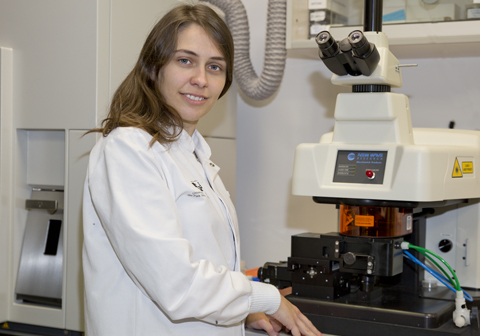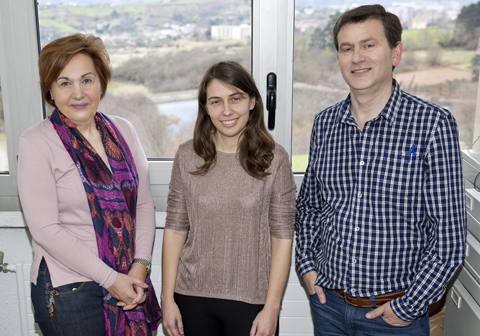The study, conducted by a research group of the UPV/EHU-University of the Basque Country, has analysed the diet of Muslim individuals at the Tauste (Zaragoza) site and has determined the differences existing in diet according to sex and age. This piece of work is part of the PhD thesis being written up by the geologist Iranzu Laura Guede about diet and mobility in the medieval period in the north of the Iberian Peninsula.
Diet and mobility end up recorded in our bones and in our teeth
A piece of research has applied standard geological techniques and methods at an architectural site in Zaragoza to establish the diet of individuals
- Research
First publication date: 09/02/2017

This study has applied techniques belonging to geology to address the unknowns that have arisen in other disciplines such as archaeology or anthropology at the archaeological site at Tauste (Zaragoza). Excavations carried out in this municipality disinterred the skeletons of 44 Muslim individuals who lived between the 8th and 10th centuries. On the basis of this discovery, a research group from the UPV/EHU's Department of Mineralogy and Petrology in the Geology Section undertook to analyse dental samples of these human remains to establish the diet of this medieval Muslim community.
The researcher Guede used the technique of laser ablation to carry out targeted analyses of the teeth. One of the features of this technique is that the sample does not need a lot of preparation and that, furthermore, it is not particularly aggressive on the fossil remains. So it allows such remains, which in archaeology are limited, to be conserved, thus preserving them for future studies.
The chemical results have uncovered the existence of considerable differences in the food of adult men compared with that of women and younger people. It has been confirmed that adult males ate more protein of animal origin than the women and younger people, whose diets were richer in pulses and vegetables.
The analyses carried out by this research group have to be anchored in the studies of historians, anthropologists and the archaeologists themselves. "Numerical data on their own indicate nothing, but they are essential for supporting the hypotheses and discoveries of archaeologists and historians," stressed Dr Zuluaga, one of the supervisors of Guede's PhD thesis. That is why, even if "we cannot find out exactly the origin of the animal protein through these analyses, we can assume that it came above all from sheep and goats on the basis of written texts and anthropological knowledge about medieval Muslim society".
In this respect, studies of this type provide proof that "we are what we eat", according to Samuel Epstein (1951), a geologist famous for developing methods for analysing stable isotopes. "What we eat goes on to form part of our bodies and provides us with very valuable information that ends up recorded in us," in this case in our teeth.
The study has focussed on the dentine as it is, according to the geologist Iranzu Guede, "more suitable" than dental enamel for establishing diet: "the chemical composition of the dentine is gradually remodelled throughout our lives and that is why the elements that form part of our diet are recorded during the final years of people's lives".
Besides the food issue, the research has also made other very interesting discoveries such as high lead concentrations in the dentine of four individuals. "The concentration of lead is so high that it suggests that they were poisoned by this element," stressed this young researcher. The origin of this element is anthropogenic and, according to various studies, could be due to the work they did involving the handling of lead minerals, possibly in the production of glazes for ceramics.
The mystery of the woman with the earring
Among the individuals found stands out a woman who was buried with an earring. "This is a very curious fact as Muslims never buried anyone with jewels or other elements belonging to their lifetimes," explained Iranzu Guede. According to the mobility studies that this PhD student is carrying out, "it has been possible to confirm that this woman was born in the town of Tauste, lived outside it for a long time and then returned a few years before her death, although the reasons for her journey will always remain unknown".
This research has also been able to show that this Muslim community was a stable community since, with the exception of two foreign men and women, most of the people were born and died in Tauste.
Site with 4,500 individuals
This site was discovered as a result of work carried out on the public thoroughfare of the municipality; subsequently, the cultural association "El Patiaz" carried out various interventions between 2010 and 2013. The excavations were conducted under the supervision of the archaeologist Francisco Javier Gutiérrez, who believes there could be up to 4,500 graves across the two hectares that may have been occupied by this necropolis. The anthropological study of the human remains discovered has been carried out by the anthropologist Miriam Pina.
At the same time, carbon 14 dating establishes that this population lived between the 8th and 10th centuries during a febrile era following the conquest by the Muslims. In fact, these pieces of research have been essential in confirming the Muslim presence in a settlement in which their existence had been unknown.
The study by Iranzu Guede is part of her PhD thesis supervised by Dr Maria Cruz Zuluaga and Dr Luis Ángel Ortega and which studies the mobility and diet in different settlements during the Middle Ages in the north of the Iberian Peninsula.
Bibliographic reference
- Analyses of human dentine and tooth enamel by laser ablation-inductively coupled plasma-mass spectrometry (LA-ICP-MS) to study the diet of medieval Muslim individuals from Tauste
- Microchemical Journal
- DOI: 10.1016/j.microc.2016.10.005







